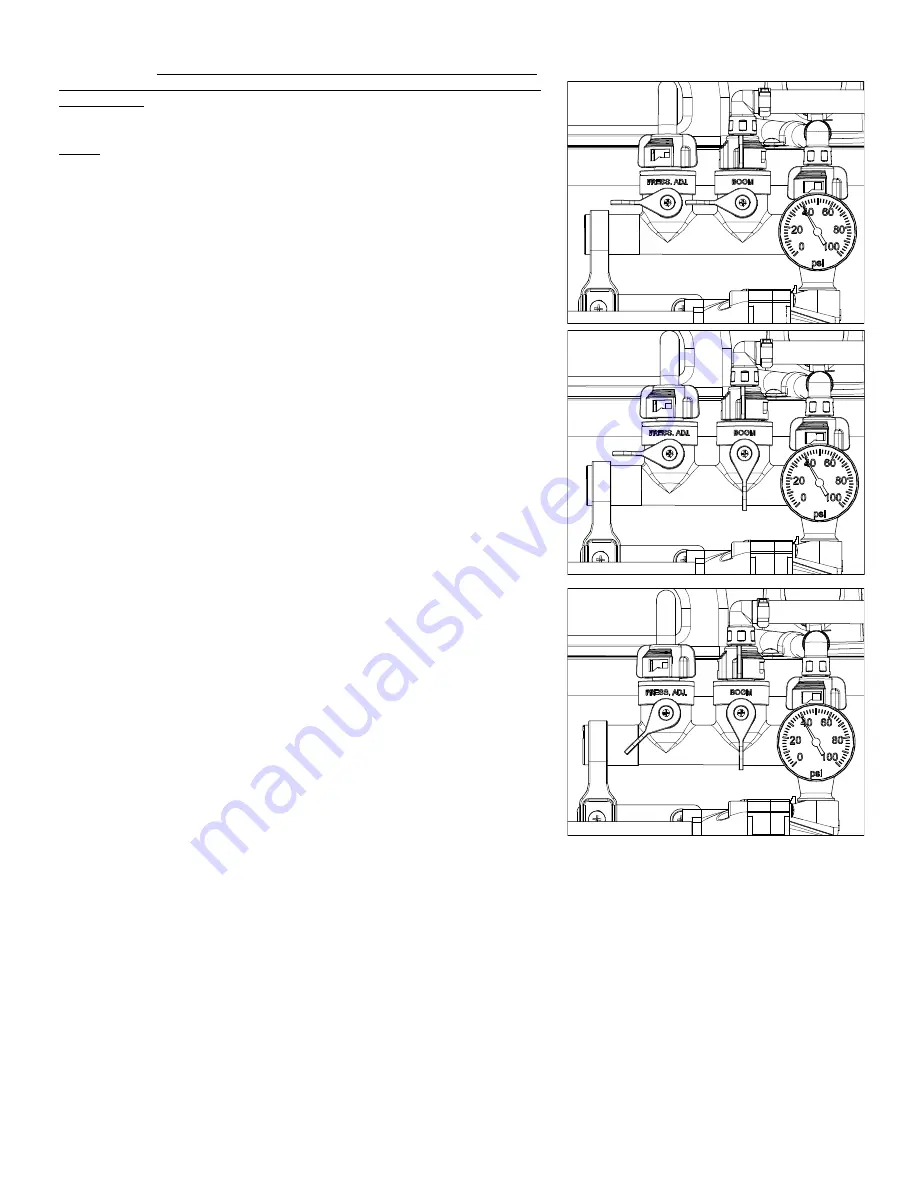
Page 3
Manifold Valves CLOSED
IMPORTANT:
Remove tank lid and be sure the tank is clean and free of
any foreign material. Rinse tank out of any tank residue before filling with
water to test.
Testing the Sprayer
NOTE:
It is VERY important for you to test your sprayer with plain water before actual
spraying is attempted. This will enable you to check the sprayer for leaks without
the possibility of losing any expensive chemicals.
Fill the tank about 1/2 full with plain water and drive to the starting place for spraying.
When you are ready to spray, turn the boom valve to the “on” position (Detail A). This will start
solution spraying from the tips of the boom. The pressure will decrease slightly when the
boom is spraying.
Adjust the pressure by turning the “ON/OFF” valve lever on the bypass line valve (Detail B).
Make sure your pattern is sufficient. You may down-pressure the system by ‘bypassing’ solu-
tion back into the tank. This is achieved by opening the bypass valve. Regulating pressure is
done in this manner.
Read the operating instructions and initially begin spraying by closing the ‘Pressure Adjust’
valve and opening the boom line valve (Detail A). This will enable the air in the line to be elimi-
nated (purged) through all the tips, while building pressure. When everything tests all right (no
leaks and good pressure), add the desired chemicals to the mixture and water combination
and start your spraying operation. Adjust the pressure and spray as you did in the testing
procedure.
Conditions of weather and terrain must be considered when setting the sprayer. Do not spray
on windy days. Protective clothing must be worn in some cases.
Be sure to read the chemical label(s) before application!
Operation
The pumping system draws solution from the tank, through the strainer and to the pump. The
pump forces the solution under pressure to the handgun or boom nozzles.
Connect the lead wire to a fully charged 12 volt battery. You may use either a stand-alone
battery or the battery on your towing vehicle. Connect to the positive (red) terminal first, then
connect to the negative (black) terminal. Then connect the end of the lead wire to the end of
the pump. When disconnecting, disconnect the end of the pump wire from the lead wire, then
disconnect the negative (black) connection and finally the positive (red) connection. The lead
wire has an On/Off switch to activate the pump. “-” is on and “O” is off.
Fill the tank part way with water and then add the desired amount of chemical to be sprayed.
Finish filling tank to proper level. Turn the pump on and by depressing the “-” side of the rock-
er switch. The pump is equipped with a pressure switch that is pre-set at the factory to shut
the pump off when all discharges are closed.
The pump will turn back on when one of the following actions occurs:
Handgun lever is squeezed to spray the handgun.
Boom valve is opened to broadcast spray with the boom.
Bypass valve is opened to re-circulate solution back into the tank.
When spraying with either the boom or the handgun, pressure may be reduced by slowly
opening the bypass valve until desired pressure is achieved. Opening the valve decreases
pressure, closing the valve increases pressure. When spraying with the boom, the proper
method to set the pressure is to open the boom valve completely and if a lower pressure is
desired, then slowly open the bypass valve until that pressure is obtained.
For the safest and most efficient chemical application, you will need to calibrate your sprayer using the tip and speed charts. Once you have deter-
mined the proper speed and pressure settings, you will need to consult your chemical label for the amount of chemical to be added to the tank. Read
the entire label. Use only according to label directions.
Calibration
Chemical labels may show application rates in gallons per acre, gallons per 1000 square feet or gallons per 100 square feet. You will note that the tip
chart shows 2 of these rating systems. Once you know how much you are going to spray, then determine (from the tip chart) the spraying pressure
(PSI), and the spraying speed (MPH).
Determining the proper speed of the pulling vehicle can be done by marking off 100, 200 & 300 feet. The speed chart indicates the number of seconds
it takes to travel the distances. Set the throttle and with a running start, travel the distances. Adjust the throttle until you travel the distances in the
number of seconds indicated by the speed chart. Once you have reached the throttle setting needed, mark the throttle location so you can stop and go
again, returning to the same speed.
Add water and proper amount of chemical to the tank and drive to the starting place for spraying.
Detail A
Detail B
Summary of Contents for 5302947
Page 11: ...Page 11 NOTES ...






























